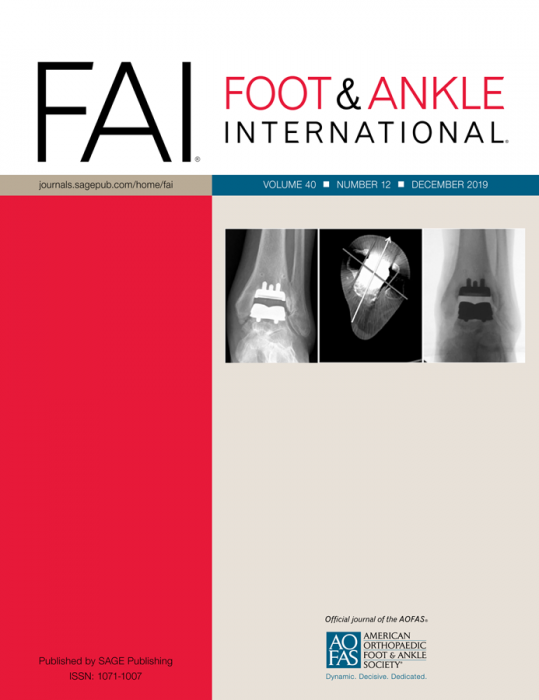
Primary arthrodesis may reduce rate of follow-up surgery in acute Lisfranc injuries

Primary arthrodesis may reduce rate of follow-up surgery in acute Lisfranc injuries
Primary Open Reduction Internal Fixation Versus Primary Arthrodesis for Lisfranc Injuries: A Prospective Randomized Study
Foot Ankle Int. 2009 Oct;30(10):913-22.Did you know you're eligible to earn 0.5 CME credits for reading this report? Click Here
Synopsis
32 patients (25 at last follow-up) with acute tarsometatarsal joint fractures or fracture dislocations were randomized to receive primary arthrodesis (PA) or primary open reduction and internal fixation (PORIF). This study evaluated whether the PA procedure produced improved functional outcomes and fewer secondary surgeries. The results at all-time points (3, 6, 12, 24 months) indicated that there were no physical function differences reported for Short Form-36 (SF- 36) and Short Musculoskeletal Function Assessment (SMFA) scores. The PA procedure resulted in fewer planned/unplanned secondary surgeries compared to PORIF.
Was the allocation sequence adequately generated?
Was allocation adequately concealed?
Blinding Treatment Providers: Was knowledge of the allocated interventions adequately prevented?
Blinding Outcome Assessors: Was knowledge of the allocated interventions adequately prevented?
Blinding Patients: Was knowledge of the allocated interventions adequately prevented?
Was loss to follow-up (missing outcome data) infrequent?
Are reports of the study free of suggestion of selective outcome reporting?
Were outcomes objective, patient-important and assessed in a manner to limit bias (ie. duplicate assessors, Independent assessors)?
Was the sample size sufficiently large to assure a balance of prognosis and sufficiently large number of outcome events?
Was investigator expertise/experience with both treatment and control techniques likely the same (ie.were criteria for surgeon participation/expertise provided)?
Yes = 1
Uncertain = 0.5
Not Relevant = 0
No = 0
The Reporting Criteria Assessment evaluates the transparency with which authors report the methodological and trial characteristics of the trial within the publication. The assessment is divided into five categories which are presented below.
4/4
Randomization
2/4
Outcome Measurements
3/4
Inclusion / Exclusion
4/4
Therapy Description
4/4
Statistics
Detsky AS, Naylor CD, O'Rourke K, McGeer AJ, L'Abbé KA. J Clin Epidemiol. 1992;45:255-65
The Fragility Index is a tool that aids in the interpretation of significant findings, providing a measure of strength for a result. The Fragility Index represents the number of consecutive events that need to be added to a dichotomous outcome to make the finding no longer significant. A small number represents a weaker finding and a large number represents a stronger finding.
Why was this study needed now?
The tarsal-metatarsal joint (TMT) or Lisfranc complex is a vital component in supporting the transverse arch of the midfoot. Dislocations and fracture-dislocations of the TMT are commonly associated with long term disability due to osteoarthritis or residual deformities. The authors suggest that PA may result in better functional outcomes and fewer follow-up surgeries when compared to primary ORIF. Therefore, this study aimed to compare the clinical and radiographic outcomes associated with these two treatment methods.
What was the principal research question?
Does PA treatment of patients with TMT injuries result in better functional outcomes and reduced rate of follow-up surgery when compared to traditional primary ORIF?
What were the important findings?
- No statistically significant differences in terms of physical function were seen on the SF-36 or SMFA scores at any follow up time points (p> 0.05)
- The rate of planned and unplanned follow-up surgeries was significantly different between the two groups: 78.6% in primary ORIF vs. 16.7% in PA (p< 0.05)
- The PA group showed a trend towards better SMFA index and SF-36 scores, however this only reached significance for the arm/hand index of the SMFA. At 3 months compared to the 6-, 12- and 24-month intervals, time had significant effect on improved physical functioning, decreased disability, and increased social functioning measured on the SF-36. It also had an effect on improved daily activity, mobility, and physical function, measured on the SMFA (p < 0.05).
- There were no significant differences in patient satisfaction between the groups, assessed via a telephone follow-up at 53 months (PORIF (9/10, 90%) versus PA (12/13, 92%); p>0.05).
- At 2 years, 14/14 (100%) of the patients in the PORIF group had anatomic reductions, whereas 17/18 patients (94%) in the PA group had solid fusion and anatomic reductions.
- At 2 years, 11 patients (79%) in the PORIF group required hardware removal surgery and 3 patients (17%) in the PA group required additional surgeries (3 hardware removals, one symptomatic screw, two hardware removals due to patient request). This difference was statistically significant (p<0.05).
- In terms of complications, there was one incidence of an asymptomatic broken screw in the PORIF group. In the PA group, complications included one delayed union (due to a broken screw), one non-union, one case of superficial cellulitis. In either group, there were no deep infections or neural injury.
What should I remember most?
Both primary open reduction internal fixation (ORIF) and primary arthrodesis (PA), lead to improved functional outcomes in patients with tarsometatarsal joint fractures. However, PA significantly reduces the rate of secondary operations when compared to primary ORIF.
How will this affect the care of my patients?
Although this study suggests a decreased rate of follow-up operation in patients with primary arthrodesis, this study lacks a large sample size and has weak external validity.
Learn about our AI Driven
High Impact Search Feature
Our AI driven High Impact metric calculates the impact an article will have by considering both the publishing journal and the content of the article itself. Built using the latest advances in natural language processing, OE High Impact predicts an article’s future number of citations better than impact factor alone.
Continue



 LOGIN
LOGIN

Join the Conversation
Please Login or Join to leave comments.